
Diving into Pool Safety: A STEM Design Challenge using the Micro:bit
- Subject:
- Computer Science
- Engineering
- Material Type:
- Activity/Lab
- Author:
- Kimberly Herskowitz
- Lauren Beal
- Rachael Haverstick
- Date Added:
- 07/16/2020

Diving into Pool Safety: A STEM Design Challenge using the Micro:bit

Students design, build and test model roller coasters using foam tubing. The design process integrates energy concepts as they test and evaluate designs that address the task as an engineer would. The goal is for students to understand the basics of engineering design associated with kinetic and potential energy to build an optimal roller coaster. The marble starts with potential energy that is converted to kinetic energy as it moves along the track. The diameter of the loops that the marble traverses without falling out depends on the kinetic energy obtained by the marble.
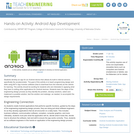
Students develop an app for an Android device that utilizes its built-in internal sensors, specifically the accelerometer. The goal of this activity is to teach programming design and skills using MIT's App Inventor software (free to download from the Internet) as the vehicle for learning. The activity should be exciting for students who are interested in applying what they learn to writing other applications for Android devices. Students learn the steps of the engineering design process as they identify the problem, develop solutions, select and implement a possible solution, test the solution and redesign, as needed, to accomplish the design requirements.
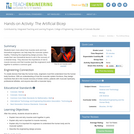
Students learn more about how muscles work and how biomedical engineers can help keep the muscular system healthy. Following the engineering design process, they create their own biomedical device to aid in the recovery of a strained bicep. They discover the importance of rest to muscle recovery and that muscles (just like engineers!) work together to achieve a common goal.
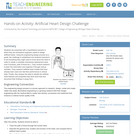
Students are presented with a hypothetical scenario in which they are biomedical engineers asked to design artificial hearts. Using the engineering design process as a guide, the challenge is established and students brainstorm to list everything they might need to know about the heart in order to create a complete mechanical replacement (size, how it functions, path of blood etc.). They conduct research to learn the information and organize it through various activities. They research artificial heart models that have already been used and rate their performance in clinical trials. Finally, they analyze the data to identify the artificial heart features and properties they think work best and document their findings in essay form.
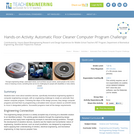
Students learn more about assistive devices, specifically biomedical engineering applied to computer engineering concepts, with an engineering challenge to create an automatic floor cleaner computer program. Following the steps of the design process, they design computer programs and test them by programming a simulated robot vacuum cleaner (a LEGO® robot) to move in designated patterns. Successful programs meet all the design requirements.
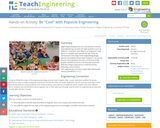
Beginning kindergarteners are introduced to science and engineering concepts through questions such as “What is a Scientist?” and “What is an Engineer?”, and go on to compare and contrast the two. They are introduced to five steps of the engineering design process and explore these steps using the “I do, we do, you do” set of guided instruction. At the end of the project, students produce a set of purple popsicles that they design using various materials and by following a set of criteria.
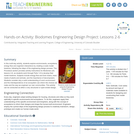
In this multi-day activity, students explore environments, ecosystems, energy flow and organism interactions by creating a scale model biodome, following the steps of the engineering design process. The Procedure section provides activity instructions for Biodomes unit, lessons 2-6, as students work through Parts 1-6 to develop their model biodome. Subjects include energy flow and food chains, basic needs of plants and animals, and the importance of decomposers. Students consider why a solid understanding of one's environment and the interdependence of an ecosystem can inform the choices we make and the way we engineer our own communities. This activity can be conducted as either a very structured or open-ended design.
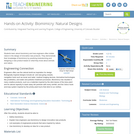
Students learn about biomimicry and how engineers often imitate nature in the design of innovative new products. They demonstrate their knowledge of biomimicry by practicing brainstorming and designing a new product based on what they know about animals and nature.
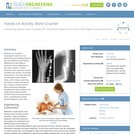
Students use a tension-compression machine (or an alternative bone-breaking setup) to see how different bones fracture differently and with different amounts of force, depending on their body locations. Teams determine bone mass and volume, calculate bone density, and predict fracture force. Then they each test a small animal bone (chicken, turkey, cat) to failure, examining the break to analyze the fracture type. Groups conduct research about biomedical challenges, materials and repair methods, and design repair treatment plans specific to their bones and fracture types, presenting their design recommendations to the class.

After learning, comparing and contrasting the steps of the engineering design process (EDP) and scientific method, students review the human skeletal system, including the major bones, bone types, bone functions and bone tissues, as well as other details about bone composition. Students then pair-read an article about bones and bone growth and compile their notes to summarize the article. Finally, students complete a homework assignment to review the major bones in the human body, preparing them for the associated activities in which they create and test prototype replacement bones with appropriate densities. Two PowerPoint(TM) presentations, pre-/post-test, handout and worksheet are provided.
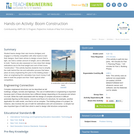
Student teams design their own booms (bridges) and engage in a friendly competition with other teams to test their designs. Each team strives to design a boom that is light, can hold a certain amount of weight, and is affordable to build. Teams are also assessed on how close their design estimations are to the final weight and cost of their boom "construction." This activity teaches students how to simplify the math behind the risk and estimation process that takes place at every engineering firm prior to the bidding phase when an engineering firm calculates how much money it will take to build the project and then "bids" against other competitors.

Students learn about and experiment with the concept of surface tension. How can a paper clip "float" on top of water? How can a paper boat be powered by soap in water? How do water striders "walk" on top of water? Why do engineers care about surface tension? Students answer these questions as they investigate surface tension and surfactants.
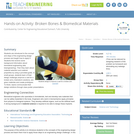
Students are introduced to the concept and steps of the engineering design process and taught how to apply it. Students first receive some background information about biomedical engineering (aka bioengineering). Then they learn about material selection and material properties by using a provided guide. In small groups, students learn of their design challenge (improve a cast for a broken arm), brainstorm solutions, are given materials and create prototypes. To finish, teams communicate their design solutions through class poster presentations.
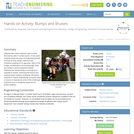
Athletes often wear protective gear to keep themselves safe in contact sports. In this spirit, students follow the steps of engineering design process as they design, build and test protective padding for an egg drop. Many of the design considerations surrounding egg drops are similar to sports equipment design. Watching the transformation of energy from potential to kinetic, observing the impact and working under material constraints introduces students to "sports engineering" and gives them a chance to experience some of the challenges engineers face in designing equipment to protect athletes.
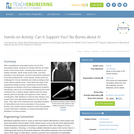
After completing the associated lesson and its first associated activity, students are familiar with the 20 major bones in the human body knowing their locations and relative densities. When those bones break, lose their densities or are destroyed, we look to biomedical engineers to provide replacements. In this activity, student pairs are challenged to choose materials and create prototypes that could replace specific bones. They follow the steps of the engineering design process, researching, brainstorming, prototyping and testing to find bone replacement solutions. Specifically, they focus on identifying substances that when combined into a creative design might provide the same density (and thus strength and support) as their natural counterparts. After iterations to improve their designs, they present their bone alternative solutions to the rest of the class. They refer to the measured and calculated densities for fabricated human bones calculated in the previous activity, and conduct Internet research to learn the densities of given fabrication materials (or measure/calculate those densities if not found online).
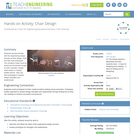
Students become familiar with the engineering design process as they design, build and test chair prototypes. The miniature chairs must be sturdy and functional enough to hold a wooden, hinged artist model or a floppy stuffed animal. They use their prototypes to assess design strengths and weaknesses.
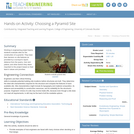
Working in engineering project teams, students evaluate sites for the construction of a pyramid. They base their decision on site features as provided by a surveyor's report; distance from the quarry, river and palace; and other factors they deem important to the project based on their team's values and priorities.
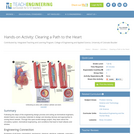
Following the steps of the engineering design process and acting as biomedical engineers, student teams use everyday materials to design and develop devices and approaches to unclog blood vessels. Through this open-ended design project, they learn about the circulatory system, biomedical engineering, and conditions that lead to heart attacks and strokes.
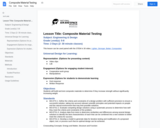
Students will build and test composite materials to determine if they increase strength without significantly increasing weight.